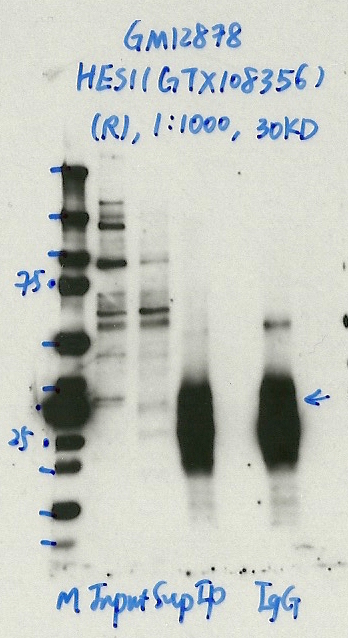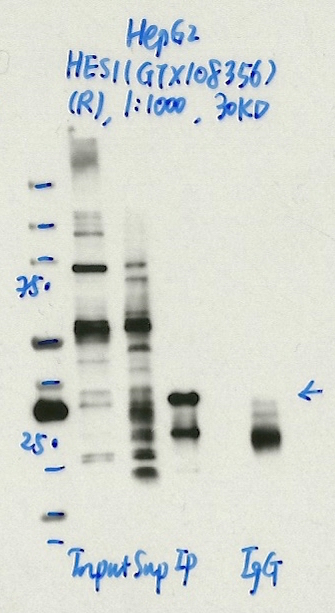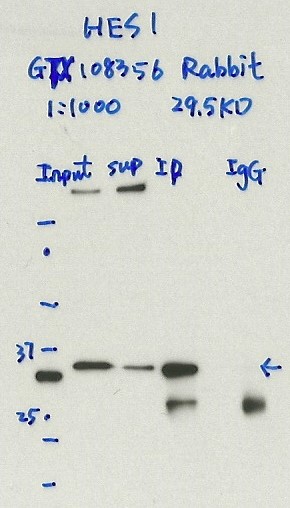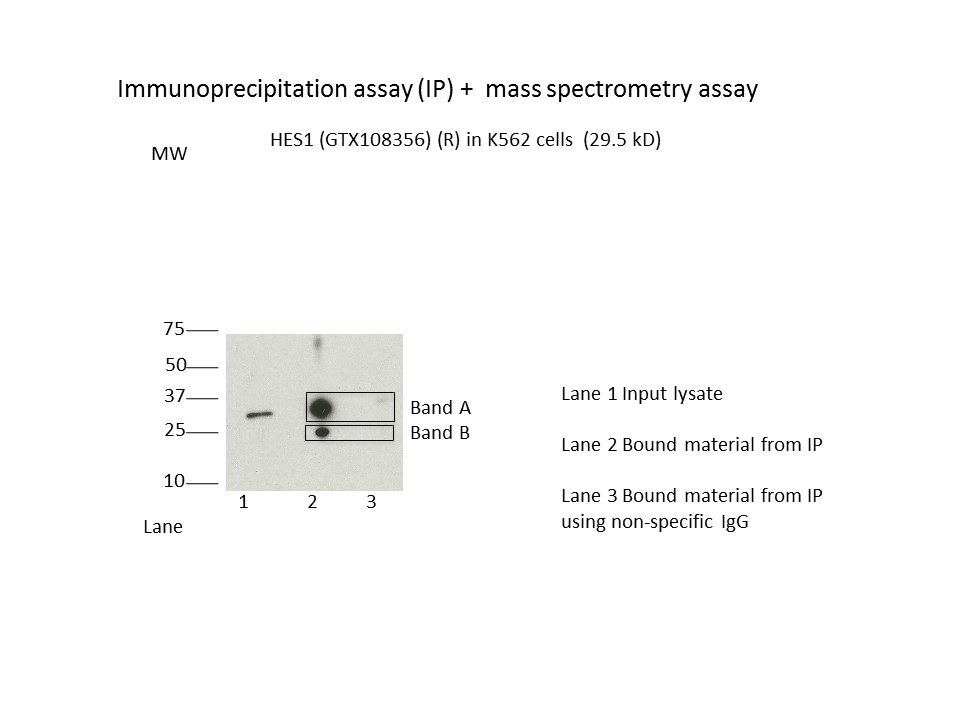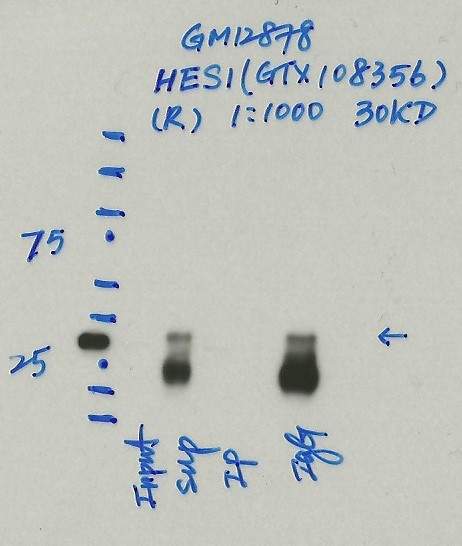ENCAB724OQW
Antibody against Homo sapiens HES1
Homo sapiens
K562, MCF-7, HepG2
characterized to standards
Homo sapiens
any cell type or tissue, GM12878
partially characterized
- Status
- released
- Source (vendor)
- GeneTex
- Product ID
- GTX108356
- Lot ID
- 39946
- Characterized targets
- HES1 (Homo sapiens)
- Host
- rabbit
- Clonality
- polyclonal
- Purification
- affinity
- Isotype
- IgG
- Antigen description
- Synthetic peptide corresponding to region within amino acids 1 and 45 of HES1 (Uniprot ID#Q14469)
- External resources
Characterizations
HES1 (Homo sapiens)
not submitted for review by lab
- Caption
- Immunoprecipitation was performed on nuclear extracts from the cell line: GM12878, using the antibody GTX108356. The blot shows western blot analysis of input, flowthrough, immunoprecipitate and mock immunoprecipitate using IgG.Molecular Weight: 29.541
- Submitted by
- Denis Salins
- Lab
- Michael Snyder, Stanford
- Grant
- U54HG006996
- Download
- 1088_09_HES1_GTX108356.jpg
HES1 (Homo sapiens)
HepG2
compliant
- Caption
- Immunoprecipitation was performed on nuclear extracts from the cell line: HepG2, using the antibody GTX108356. The blot shows western blot analysis of input, flowthrough, immunoprecipitate and mock immunoprecipitate using IgG.Molecular Weight: 29.541
- Submitted by
- Denis Salins
- Lab
- Michael Snyder, Stanford
- Grant
- U54HG006996
- Download
- 1088_10_HES1_GTX108356.jpg
HES1 (Homo sapiens)
K562
compliant
- Caption
- Immunoprecipitation was performed on nuclear extracts from the cell line: K562, using the antibody GTX108356. The blot shows western blot analysis of input, flowthrough, immunoprecipitate and mock immunoprecipitate using IgG.Molecular Weight: 29.541
- Submitted by
- Denis Salins
- Lab
- Michael Snyder, Stanford
- Grant
- U54HG006996
- Download
- expt1042_4.jpg
HES1 (Homo sapiens)
MCF-7
compliant
- Caption
- Immunoprecipitation was performed on nuclear extracts from the cell line: MCF-7, using the antibody GTX108356. The blot shows western blot analysis of input, flowthrough, immunoprecipitate and mock immunoprecipitate using IgG.Molecular Weight: 29.541
- Submitted by
- Denis Salins
- Lab
- Michael Snyder, Stanford
- Grant
- U54HG006996
HES1 (Homo sapiens)
K562
compliant
- Caption
- Immunoprecipitation of HES1 from K562 cells using GTX108356. Lane 1: input nuclear lysate. Lane 2: material immunoprecipitated with GTX108356. Lane 3: material immunoprecipitated using control IgG. Band A and Band B were excised from gel and subject to analysis by mass spectrometry. The expected band size is 29.5 kDa.
- Submitted by
- Kathrina Onate
- Lab
- Michael Snyder, Stanford
- Grant
- U54HG006996
- Download
- HES1.jpeg
HES1 (Homo sapiens)
compliant
- Caption
- The motif for target HES1 is represented by the attached position weight matrix (PWM), and is derived from ENCFF371SXN. Motif enrichment analysis was done by Dr. Zhizhuo Zhang (Broad Institute, Kellis Lab) using known motifs (http://compbio.mit.edu/encode-motifs/) and previously published ChIP-seq data (http://www.broadinstitute.org/~zzhang/motifpipeline/data/TrainSetInfo.txt). The accept probability score of the given transcription factor was calculated using a Bayesian approach. This analysis also includes three motif enrichment scores, computed by overlapping the motif instances with the given ChIP-seq peak locations, as well as an enrichment rank. For more information on the underlying statistical methods, please see the attached document. Accept probability score: 0.606000601 Global enrichment Z-score: -0.122130725 Positional bias Z-score: 0.957355752 Peak rank bias Z-score: 1.533502608 Enrichment rank: 28.0
- Submitted by
- Minyi Shi
- Lab
- Michael Snyder, Stanford
- Grant
- U54HG006996
- Download
- HES1_ENCAB724OQW_Motif.png
HES1 (Homo sapiens)
Method: immunoprecipitation followed by mass spectrometry
not compliant
- Caption
- IP followed by mass spectrometry: Briefly, protein was immunoprecipitated from K562 nuclear cell lysates using GTX108356, and the IP fraction was loaded on a 10% polyacrylamide gel (NuPAGEBis-Tris Gel) and separated with an Invitrogen NuPAGE electrophoresis system. The gel was stained by ColloidialCoomassie G-250 stain, gel fragments corresponding to the bands indicated were excised. Then proteins were trypsinized using the in-gel digestion method. Digested proteins were analyzed on an Orbitrap Elite mass spectrometer (Thermo Scientific) by the nanoLC-ESI-MS/MS technique. Peptides were identified by the SEQUEST algorithm and filtered with a high confidence threshold (Peptide false discovery rate < 1%, 2 unique peptides per protein minimum, mass error < 10 ppm).
- Submitter comment
- Could not find any evidence to explain interaction of HNRNPAB and HES1 so far.
- Submitted by
- Kathrina Onate
- Lab
- Michael Snyder, Stanford
- Grant
- U54HG006996
- Download
- HES1_GTX108356 final.pdf
HES1 (Homo sapiens)
GM12878
not submitted for review by lab
- Caption
- Immunoprecipitation was performed on nuclear extracts from the cell line: GM12878 using the antibody GTX108356. The image shows western blot analysis of input, flowthrough, immunoprecipitate, and mock immunoprecipitate using IgG. Target molecular weight: 29.541.
- Submitted by
- Nathaniel Watson
- Lab
- Michael Snyder, Stanford
- Grant
- U54HG006996
- Download
- IP 1149 HES1(GTX108356).jpg
